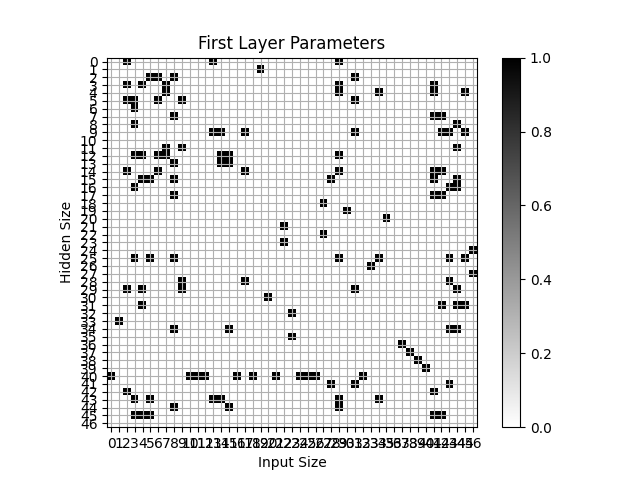Alice's warm up
大约 3 分钟
Alice's warm up —— pytorch / 搜索
题目描述
“Welcome to the XCTF-*CTF2022, I’m Alice and interested in AI security. I prepared a easy warm-up for you before you enjoy those pure AI security challenges.
Like humans, AI also needs to warm up before running. Can you find something strange in these initialized parameters?”
思路
- 关注模型的初始参数
- (不是)纯粹 ai 问题
第一步:加载模型
- 需要注意:AI 模型文件和当前的 AI 模型不同
- AI 模型文件:完整清晰的模型结构的文件
- 当前 AI 模型:更多的是黑盒
- 获取的文件为
xxx.zip,注意 pytorch 模型保存的文件结构,模型本身就是zip- 其结构就是:archive 文件夹,诺干个 AI 模型文件
- 因此,直接用
torch.load导入zip文件即可
path = 'Alice_warm_up.zip'
net = torch.load(path)
直接加载的时候,会报了一个错:
AttributeError: Can't get attribute 'AliceNet1' on <module '__main__' from 'xxxx/xxx.py'>
这是因为载入模型的时候,还需要先恢复模型,这里报错缺少AliceNet1类,那我们就直接补上一个空的类就可以
class AliceNet1(nn.Module):
pass
找到模型中的特殊点
- 看看网络结构:47x10x1的全连接网络
AliceNet1(
(fc): Sequential(
(0): Linear(in_features=47, out_features=47, bias=True)
(1): Linear(in_features=47, out_features=10, bias=True)
(2): Linear(in_features=10, out_features=1, bias=True)
)
)
47*10*1
- 输出 net 中的参数看看怎个事:发现除了第0层只有0和1,其他都是正常矩阵
[-1,1]- 这里使用 pytorch 的
state_dict()可以获取每层参数名
- 这里使用 pytorch 的
for name in net.state_dict():
print(net.state_dict()[name])
fc.0.weight
tensor([[0., 0., 1., ..., 0., 0., 0.],
[0., 0., 0., ..., 0., 0., 0.],
[0., 0., 0., ..., 0., 0., 0.],
...,
[0., 0., 0., ..., 0., 0., 0.],
[0., 0., 0., ..., 0., 0., 0.],
[0., 0., 0., ..., 0., 0., 0.]])
fc.0.bias
tensor([-0.0481, 0.0083, 0.0302, 0.0301, -0.0125, 0.1012, 0.0500, 0.0477,
0.0310, 0.0276, -0.0967, 0.0889, -0.0678, -0.1428, 0.1141, -0.1254,
0.1439, -0.0778, 0.0316, -0.0729, 0.0046, -0.1126, -0.0916, 0.1256,
0.0641, -0.0317, 0.0422, -0.1378, -0.0489, 0.0612, 0.0500, 0.0190,
-0.0649, -0.1008, -0.1050, -0.0399, 0.0906, 0.0275, -0.0825, -0.1431,
0.1126, -0.0183, 0.1168, -0.0400, -0.0637, 0.0806, -0.0296])
fc.1.weight
tensor([[-0.0512, 0.1195, -0.0837, -0.0519, -0.0278, 0.0530, 0.1385, -0.0872,
-0.1022, -0.0910, -0.0098, 0.0995, 0.0531, -0.0997, -0.0123, -0.0347,
-0.0872, 0.0987, -0.0472, 0.0851, -0.1073, -0.0153, -0.0942, 0.0949,
0.0522, 0.0521, 0.1063, 0.1335, 0.0305, 0.1082, 0.0114, -0.1429,
-0.1264, 0.1127, -0.1318, 0.0350, 0.1166, 0.1224, 0.0600, -0.0837,
-0.0425, -0.0854, 0.0214, -0.1391, -0.0359, -0.0529, -0.0379],
...
[-0.0641, -0.1137, -0.0556, 0.1383, -0.0967, 0.0524, -0.0661, 0.0510,
-0.1030, -0.0732, 0.1109, 0.1101, -0.1164, -0.0505, -0.0610, -0.0219,
-0.1451, -0.0486, -0.0898, -0.1229, 0.1050, -0.0934, -0.0408, 0.0432,
0.0159, 0.0220, 0.0875, -0.0512, -0.0437, 0.0833, 0.0277, 0.0892,
-0.1136, -0.1330, -0.0778, 0.0363, 0.0043, 0.1038, -0.1079, -0.0030,
-0.0358, -0.1302, 0.0822, 0.0155, 0.0218, 0.0417, 0.1241]])
fc.1.bias
tensor([ 0.0427, 0.1376, -0.0805, 0.1418, 0.1263, 0.0791, -0.0008, 0.0997,
0.0499, -0.0104])
fc.2.weight
tensor([[-0.2986, -0.2412, 0.2308, -0.0410, 0.1583, -0.0777, -0.2521, 0.0848,
-0.0169, -0.0387]])
fc.2.bias
tensor([-0.1993])
- 再看看 hint.py:
- flag 长度为16
- flag 内容范围以及格式:可以通过
print(flagset)查看0123456789abcdefghijklmnopqrstuvwxyz*CTF{ALIZE}
- 同时发现,这里 flagset 中的字母数量正好是47
- 因此可以大胆猜测这里的字母和第0层的01矩阵行列是相对应的
- => 这个矩阵是一个邻接矩阵
通过输出这个矩阵图,观察

- 进一步的分析会发现,整个邻接矩阵代表的是一个带环的有向图。—— 是字母之间的联系
因此,想到了使用
- 使用 dfs 算法,最大深度16(flag长度),初始位置"*"
完整exp:
import torch
import torch.nn as nn
import string
import matplotlib.pyplot as plt
import numpy as np
class AliceNet1(nn.Module):
pass
'''
AliceNet1(
(fc): Sequential( (0): Linear(in_features=47, out_features=47, bias=True) (1): Linear(in_features=47, out_features=10, bias=True) (2): Linear(in_features=10, out_features=1, bias=True) ))
47*10*1
(36,37)->"*"
(37,38)->"C"
(38,39)->"T"
(39,40)->"F"
(40,41)->"{"
'''
# for name in net.state_dict():
# print(name)
# print(net.state_dict()[name])
# print(mymat[36][37])
# 绘制第一层参数图
# plt.imshow(mymat, cmap='binary', interpolation='nearest')
# plt.title('First Layer Parameters')
# plt.colorbar()
# plt.xlabel('Input Size')
# plt.ylabel('Hidden Size')
# plt.xticks(np.arange(0, mymat.shape[1], 1))
# plt.yticks(np.arange(0, mymat.shape[0], 1))
# plt.grid(True)
# plt.show()
# print(string.printable[0:36].find('r'))
def char2num(ch):
tmpset = string.printable[0:36] + '*CTF{ALIZE}'
tmplen = len(tmpset)
# print(tmpset)
for i in range(tmplen):
if (ch == tmpset[i]):
return i
def dfs(ch,depth,ans):
ans += ch
if len(ans)==flaglen and ans[-1]=='}':
print('get flag: ',ans)
exit(0)
elif len(ans)==flaglen:
return
else:
tmpi = char2num(ch)
for i in range(setlen):
if flagset[i]==ch:
continue
tmpj = char2num(flagset[i])
if mymat[tmpi][tmpj]==1.0 and used[tmpj]==False:
# print(ans)
used[tmpj]=True
dfs(flagset[i],depth+1,ans)
used[tmpj]=False
path = 'Alice_warm_up.zip'
net = torch.load(path)
# print(net)
mymat = net.state_dict()['fc.0.weight'].tolist()
flagset = string.printable[0:36] + '*CTF{ALIZE}'
print(flagset)
setlen = len(flagset)
flaglen = 16
used = [0] * setlen
flag = ''
used[char2num('*')]=1
dfs('*',0,flag)
得到flag:*CTF{qx1jukznmr}
